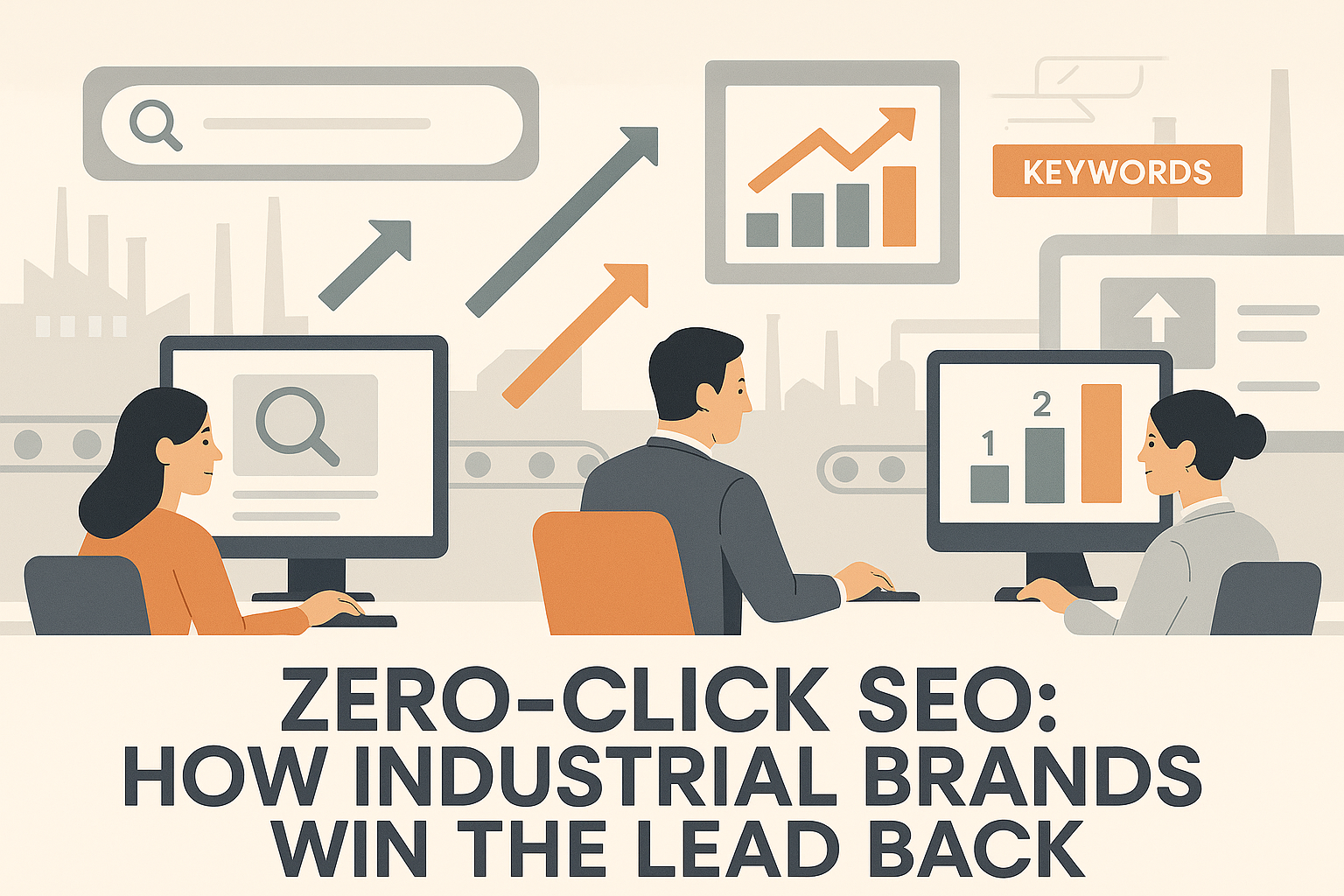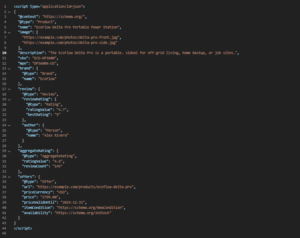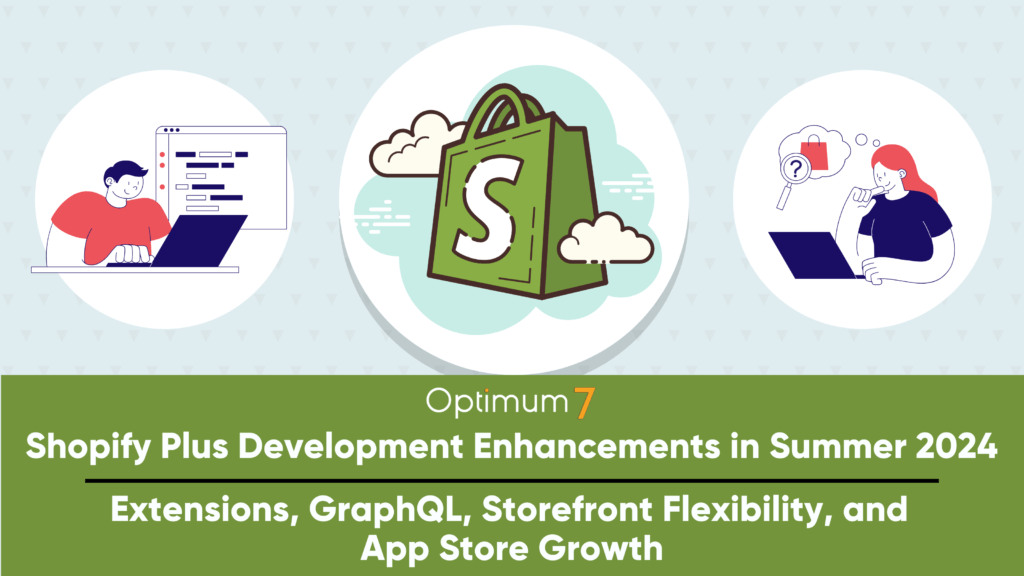Google’s AI is now answering your buyers’ questions—without sending them to your site. For industrial manufacturers, that means your spec sheets and product data are feeding zero-click search… while your lead flow dries up. This isn’t just an SEO problem. It’s a visibility, conversion, and revenue problem. In this guide, we’ll show you how to fight back—using schema, CRO, and on-page strategy built for a post-clickless world.
The Organic Cliff No One Wants to Admit
You didn’t change your SEO strategy. Google did.
Not in a small way—not in the way that triggers a few keyword shifts or re-optimizations. In a way that fundamentally restructures what the search engine does with your content and whether your buyer ever clicks through.
The pain isn’t always loud at first. It starts with a flattening. Your organic traffic stops climbing. Then it dips. Bounce rates go up. Lead quality drops. Eventually, your sales team starts complaining that inbound leads are “weak” or that fewer RFQs are coming in from search.
But when you check rankings? You’re still there. You’re still technically “winning.”
That’s what makes it so deceptive.
Because what’s actually happening is that your product data—spec sheets, torque ratings, ISO tolerances—the stuff you’ve spent years optimizing—is now being scraped and summarized by Google’s AI Overviews.
Your rankings haven’t dropped. But your leads have. That’s the trap. Visibility gives the illusion of success while your pipeline quietly erodes.
And Google’s not just rewarding relevance anymore. It’s evaluating topical authority—deciding which brands deserve the click, and which become just another data source.
Buyers get the answer. But they never get to you.
It’s a quiet, brutal shift.
And industrial manufacturers are feeling it more than anyone.
Because in this space, your content isn’t fluff. It’s not brand storytelling or lifestyle guides. It’s technical documentation—the very thing Google loves to summarize and scrape into a zero-click answer.
- PSI range for aluminum regulators? Answered.
- Torque output of your gearbox? Extracted.
- ISO 9001 compliance spec? Pulled into the AI card.
- Thread pitch conversion chart? “According to …”
You’re feeding the machine. And it’s starving your funnel.
The Rise of Zero-Click Industrial Search
If you sell to engineers, procurement leads, and facility managers, your site has long relied on informational traffic that eventually converts.
That’s dead if you don’t adapt.
Because those searchers are increasingly being trained to take action without clicking. Not because they’re lazy, but because Google is making it frictionless.
- AI Overviews now appear on >60% of B2B technical queries.
- Featured snippets, FAQ blocks, and People Also Ask occupy the upper fold.
- Only 34% of zero-click searchers ever scroll down, let alone click.
Your FAQs? Now, answer fodder for Gemini and Bard.
Search engine marketing is no longer about visibility alone—it’s about influence and interaction. If you’re still treating SEO like a traffic-generation game—or haven’t refreshed your understanding of SEO basics—you’re already behind.
This is no longer about driving people to your site to educate them.
It’s about showing up in AI while still engineering a lead capture path.
And that’s the hard part.
Because it requires a total rethink of how you publish, structure, and gate your content, without hiding your value.
What the Best Are Doing Differently
We’ve worked with industrial brands who’ve watched this erosion happen in real time — and rebuilt smarter.
The solution isn’t to block AI agents like ChatGPT or Perplexity. You’ll disappear.
It’s not to rewrite everything just to “stand out.” That’s a fast way to get flattened by machine-parsed summaries.
And it’s definitely not to lean harder on paid search — that’s just an expensive way to chase traffic AI is already absorbing for free.
The ones who win are doing three things:
- Feeding the AI layer on their terms, using a structured data that controls how product data is summarized.
- Designing on-page CRO like it’s a performance funnel, not a brochure—so that the 34% who do click are qualified and ready.
- Gating value surgically—not with annoying popups, but with functional moments: spec-sheet downloads, instant quote triggers, guided comparison tools that capture intent and info in motion.
In other words, they’re not resisting zero-click. They’re redesigning their content to win inside of it.
Not to “get clicks”—but to capture the lead, even if it’s the only click they make.
This article is your blueprint to do the same.
In the next section, I’ll show you exactly how we structure schema and FAQ snippets for AI visibility, without cannibalizing the click. You’ll get real examples from torque specs, PSI standards, ISO compliance content, and how we engineer visibility that still earns engagement.
Because if your product is being cited, but your company isn’t being contacted, you’re just training your replacement.
Feeding the Machine — The Schema Snippets That Get You Into AI Overviews Without Losing the Lead
By now, you’ve probably seen it happen in real time.
You Google a product term—‘2-inch ball valve torque range’—and before you even scan the search engine results page, you’re handed a clean, structured answer
- Torque: 17–42 Nm
- Material: Stainless Steel
- PSI: 1,000 max
- Certifications: ISO 5211, API 607
And the source? It’s your site.
But your traffic? Flat.
Your leads? Down.
Your bounce rate? Up.
Because Google’s AI Overviews, Featured Snippets, and Product Knowledge Panels are harvesting your structured data—and serving it to buyers in a way that requires zero action on their part.
And unless you change how you structure and surround that data, you’ll keep feeding the machine—and starving your pipeline.
Let’s fix that.
The Game Has Changed: Schema Is No Longer Optional
If you’re a B2B industrial site and your critical product data is being generated with JavaScript — your spec tables, features, documentation — you’re effectively invisible to AI. Tools like ChatGPT and Perplexity don’t render JavaScript. If your content isn’t in clean, static HTML, they can’t read it, can’t summarize it, and won’t surface it.
Even when your content is visible, structure still matters. AI crawlers don’t depend on schema, but they do lean on it. Structured data helps tools like Perplexity, ChatGPT, and modern search engines make sense of your information, fast. If your team hasn’t connected structured markup to your technical SEO strategy, that’s not just a metadata gap — it’s a visibility and conversion problem.
This includes:
- Product schema
- FAQPage schema
- HowTo schema
- TechnicalArticle schema
- QAPage schema
- Organization and WebPage context layering
But here’s where it gets interesting:
Schema doesn’t just influence how you show up. It determines what gets quoted and what gets skipped.
If you don’t control the fields, Google will decide what matters.
If you structure it correctly, you control what’s said, how it’s framed, and what the buyer sees next.
Here’s how we do it for industrial products that live and die by specs.
Real Example: Torque Spec Schema for Industrial Hardware
Let’s say you manufacture gear reducers or couplings. Buyers search for:
- Torque limits
- Tolerances
- Material compatibility
- IP ratings
- Output shaft sizes
You don’t need to write this from scratch—this is the exact format we deploy in real-world B2B migrations. It feeds Google’s AI the right facts without giving away everything.
Here’s how we structure the core of the product schema:
{
“@context”: “https://schema.org/“,
“@type”: “Product”,
“name”: “High-Torque Gear Reducer – Series G200”,
“description”: “Compact gear reducer with 200Nm max torque and IP65 rating.”,
“sku”: “G200-HT”,
“manufacturer”: {
“@type”: “Organization”,
“name”: “DeltaMotion Systems”
},
“additionalProperty”:
}
This is just one implementation pattern. This format helps search engines discover your specs with clarity—without giving away the full context unless you choose to. Structured data like this scales across platforms and product types—from gear reducers to industrial lighting—if it’s deployed with precision and clarity. Structured data tells Google what to say—and what to skip.
This structured data doesn’t just optimize visibility—it becomes the front line of your search marketing strategy. On the search page, Google’s search results now prioritize clarity, hierarchy, and schema-rich responses.
Now this appears cleanly in AI Overviews, Featured Snippets, and Google’s structured product carousels.
But this alone won’t get the click.
To earn that, you need to embed the FAQ schema and position the buyer’s next move right inside the interaction zone.
FAQ Schema That Creates Curiosity (Not Closure)
Most FAQ content is written to end a question. We write it to open a decision path. This shift reflects a deeper focus on search intent—not just matching terms, but matching buyer psychology.
Here’s how we do it for the same reducer:
On-page question:
What torque output does the G200 gear reducer support?
Answer (in content):
The G200 supports up to 200 Nm under standard load conditions. For dynamic loads or variable torque applications, request a performance-adjusted spec sheet.
Now embed this in the schema:
{
“@type”: “FAQPage”,
“mainEntity”:
}
What just happened?
- The AI Overview might quote the first line. But the call to action (“request a spec sheet”) stays embedded on-page.
- Embedding relevant keywords into the question and answer structure also increases your chances of being surfaced by AI—while keeping the buyer path open.
- That CTA becomes your conversion hook inside a zero-click environment.
- This is how we design intent traps that Google doesn’t summarize away.
Key Schema Patterns We Deploy for Industrial Clients
- PropertyValue blocks for PSI, torque, IP ratings, and thread pitches
- FAQ entries with soft gates (“Request a full material compatibility matrix”)
- How-to snippets when assembly or install steps are involved
- Context-layered schema that aligns the product with your company profile (boosting authority score)
And we surround all of it with on-page content that gives the user one logical next step: submit a request, start a quote, or download a gated spec.
Not every visitor will convert.
But the ones who would have converted before zero-click still do—because we’ve engineered the interaction, not just the visibility.
Post-Click Precision — CRO Patterns That Capture the Lead Before They Bounce
Let’s get brutally honest about what happens after the click—when someone breaks through Google’s AI layer and lands on your page.
You get one shot.
This isn’t 2016, where the average visitor pokes around your nav bar, reads two blog posts, and then hits “Contact.” In 2025, post-zero-click behavior is sharper, faster, and more binary.
- If your page confirms what they saw in the AI summary, but does nothing more, they bounce.
- If it looks outdated, salesy, or bloated, they close the tab.
- If the data is accurate but the next step isn’t obvious, you lose the lead.
That’s why conversion design has to be frictionless, but not passive. For industrial brands especially, we’ve outlined what works in high-spec conversion environments, where buyers make or break in 15 seconds.
Let’s walk through exactly how we do it—on pages that capture engineers, procurement leads, and project managers who were already half-satisfied by Google’s summary.
Step One: Gate the Right Thing — Not the Whole Experience
The fastest way to kill a lead? Ask for their email before they’ve even seen value.
The second fastest? Give them everything with no action required.
We strike the balance with a surgical spec-sheet gate.
Here’s how it works:
- Specs are visible. But downloadable performance-adjusted configurations are gated.
- Key data is readable (torque, PSI, material)
- But application-specific CAD drawings, compliance matrices, or exploded views? Those require a quick gate—name, email, and company size.
This does two things at once:
- Delivers value upfront (which earns trust)
- Qualifies the lead based on their intent (who downloads technical specs for fun?)
What Not to Gate
- General torque ranges
- Product compatibility summaries
- FAQs or blog articles
These must remain open to stay indexable and AI-scrapable.
Instead, we isolate gated content around:
- Custom performance matrices
- ISO documentation
- CAD files or exploded diagrams
- Spec customization interfaces (“Build this SKU for your exact output range”)
This allows Google to see enough to surface you, and the buyer to see enough to commit.
Step Two: The Instant Quote Trigger
Not everyone wants a spec sheet. Some want a price. Some want timing. Some want to see if their specific use case is compatible.
That’s where we drop in the “Instant Quote” trigger—but we don’t make it loud, orange, or floating like it’s 2008 SaaS.
We embed it directly into the content flow.
Example:
“This enclosure meets NEMA 4X standards and is compatible with vertical rack-mount applications. Need a quote for 3+ units? Get an instant lead time and pricing breakdown. We’ve had buyers tell us: ‘That quote form was way easier than calling.”
The “Get an instant quote” is a trigger, not just a button.
What happens next?
- Short form appears inline (not redirect)
- Auto-fills product name, category, and last viewed specs
- Let the user enter qty + timeline + industry
- Submits to CRM as a warm, spec-tied lead, not a cold inquiry
Why does this work so well?
Because we’re not making the user ask for help. We’re meeting them mid-solution—right when they’re mentally ready to engage, but before they click away.
CRO Design Elements That Support the Flow
- Sticky side-rail that keeps quote/spec access visible as users scroll
- Inline comparison tables with “add to quote” logic—even on info pages
- Exit-intent triggers that highlight logical next steps without annoying popups
- Quote builder overlays that preserve scroll position and never break the UX
All of this is designed to work in tandem with your schema and FAQ structure.
Remember: we want to be scrapable. But we also want to make the AI summary only part of the story.
The goal isn’t to hide anything. It’s to design the post-click path like a decision funnel, not a documentation archive.
The Difference in Performance
Clients who implement these patterns consistently report:
- Bounce rate ↓ 22–35%
- Lead capture ↑ 2–5x (depending on gating asset)
- Quote quality ↑ (better spec alignment, lower friction)
We benchmark this aggressively.
One industrial packaging client went from 0.8% to 3.9% conversion on their high-traffic reducer pages—without adding traffic. Just by restructuring how value was revealed and how engagement was captured.
You don’t need more content.
You need a smarter structure.
You need intent-based design that matches how your buyer thinks, especially in a post-zero-click world where you only have 15 seconds to matter.
Bounce vs. Lead — The Real Numbers Behind Zero-Click CRO Success
Let’s stop pretending that “traffic” is a metric.
You don’t report sessions to your CFO.
You don’t forecast bounce rate to your sales team.
And your ops lead doesn’t care if blog views go up when RFQs are down.
What you measure—what makes or breaks your SEO and CRO investment—is how many qualified leads come through the site, and whether that number is growing.
In a post-zero-click world, that means one thing: bounce-to-lead ratio.
And if you’re not tracking it, you’re already bleeding.
The New Conversion KPI: Bounce-to-Lead
Here’s how we define it:
Bounce-to-Lead Ratio = Number of Leads Captured / Number of Bounces
Why does this matter more than the traditional conversion rate?
- It isolates intent.
- It neutralizes fluff traffic.
- It forces your CRO design to focus on saving a bounce, not “improving engagement.”
This is especially relevant when most of your product traffic:
- Comes from Google
- Gets partially answered by an AI Overview
- Lands on a page they may have already half-read before clicking
You have 10–15 seconds. If they leave, it’s over. If they act, you’ve won.
No middle ground.
Let’s look at some real numbers.
Pre-Optimization Baseline (Typical Industrial Site)
Product Page: High-Torque Enclosure
Monthly Sessions: 2,500
Bounce Rate: 68%
Leads Captured: 24
Conversion Rate: 0.96%
Bounce-to-Lead Ratio: 1:71
That means for every 71 people who left, you saved 1.
That’s not terrible in the old world.
But in the new search landscape, it’s fatal. Because those 71 are qualified, behavior-trained buyers. They read your specs. They just didn’t act.
Post-Optimization (Same Page After Schema + CRO Redesign)
Product Page: Same SKU
Monthly Sessions: 2,450
Bounce Rate: 48%
Leads Captured: 92
Conversion Rate: 3.75%
Bounce-to-Lead Ratio: 1:13
We didn’t drive more traffic.
We didn’t run ads.
We didn’t rewrite all the copy.
We just:
- Structured data so AI used the right snippets
- Embedded spec sheet gates within a scroll
- Triggered quote CTAs in context
- Removed friction from the path of action
This is what modern CRO looks like: recapturing the bounce before it happens. And if you want to make sure your SEO strategy is keeping pace with these shifts, here are 7 SEO tips for eCommerce in 2025 to layer into your content and CRO plans.
Benchmarks We See Across Industrial B2B Clients
| Traffic Source | Pre-Optimization Bounce Rate | Post-Optimization Bounce Rate | Lead Conversion (Post) |
| Organic – AI Surface | 65–75% | 45–55% | 3–5% |
| Organic – Spec Queries | 55–65% | 35–45% | 4–7% |
| Direct – Returning | 30–40% | 25–30% | 6–10% |
These aren’t anomalies. This is what happens when you design not for traffic, but for motion.
How to Calculate Your Own Bounce-to-Lead Risk
Run this internal test on your top 5 product or category pages:
- Check Google Search Console for impression vs. click rate.
- Look at the bounce rate in GA4 for those pages.
- Pull form fills or quote requests tied directly to those URLs.
- Run the math: Leads / Bounces = Bounce-to-Lead Ratio
If your number is worse than 1:50, you’re in a zero-click freefall.
If your number is better than 1:20, you’re holding steady.
If you’re at 1:10 or better, you’ve built a page that fights the algorithm and wins.
And if you have high visibility but no leads, congratulations—you’re educating your competitors’ buyers.
What the Best Teams Do With This Metric
- They make it a KPI for marketing ops
- They review it quarterly for all high-spec product pages
- They tie it to sales-qualified lead targets (not just MQLs)
- They use it to prioritize CRO budget, not based on design opinions, but on data pressure
And when teams bring us in, this is the number we chase.
It doesn’t dazzle—it diagnoses.
Because in a world where traffic disappears into AI summaries, bounce-to-lead is the only metric that still tells the truth.
The 30-Day Fix — Launching Your Zero-Click SEO + CRO Recovery Sprint
You don’t need a six-month roadmap.
You need momentum.
Because the longer you wait, the more your spec sheets, product pages, and technical content become training data for Google’s AI—rather than lead generators for your team.
That’s why we don’t pitch strategy decks or content calendars first.
We start with a 30-day Zero-Click Recovery Sprint.
One month. Targeted action. Clear outcomes.
Not to “fix SEO.”
To restore the lead flow.
Let’s walk through how we structure the sprint and what industrial manufacturers get out of it.
Week 1: AI Visibility + Schema Extraction
Objective: Identify where you’re being scraped, how you’re being cited, and what your most valuable (and vulnerable) content assets are.
Deliverables:
- Audit: Full AI Overviews + Featured Snippets audit for your top 25 search terms
- Extract: Schema from current product, spec, FAQ, and blog content
- Map: “Zero-click exposed” assets vs. “non-performing” pages
- Report: Technical gap analysis for JSON-LD, microdata, and crawl coverage
Why it matters:
You can’t fight what you can’t see.
Most brands don’t realize which snippets Google is pulling, or how those snippets are structured.
We surface the hidden layer—and show you exactly where your data is being used.
Week 2: Schema Rewrite + Structured FAQ Insertion
Objective: Rebuild your technical content so that Google can still scrape it—but only on your terms, and only in ways that lead to clicks or conversions.
Deliverables:
- Rewrite: Product schema (PropertyValue, Product, TechArticle)
- Inject: FAQPage + QAPage schema with CTA-anchored answers
- Gate: Soft triggers like “Download full torque matrix” or “Get spec-adjusted CAD”
- Deploy: On-page markup updates to live or staging (CMS-dependent)
Why it matters:
This is how we shift you from passive victim to active signaler.
You’re no longer just a source of answers. You’re the origin of next steps—and every snippet pushes the buyer further into your funnel.
Week 3: CRO Redesign for 3 Target Pages
Objective: Optimize the behavior zone—the part of your top pages that either converts or loses the click forever.
Pages selected: Your 3 highest-traffic, lowest-converting product or category URLs..
Deliverables:
- Wireframe: CRO redesigns (desktop + mobile) for post-zero-click behavior
- Embed: Inline quote triggers that match scroll behavior
- Gate: Scroll-aware spec sheet downloads
- Inject: CRO copy (not banners—contextual nudges)
- Simplify: Forms via progressive disclosure or inline UX
Why it matters:
Your bounce rate isn’t caused by bad content. It’s caused by missing frictionless next steps.
We install them where they matter—without breaking the UX, brand voice, or sales flow.
Week 4: Live Testing + Benchmark Reporting
Objective: Deploy, track, and prove impact.
Deliverables:
- Configure: GA4 + Tag Manager for CRO and event tracking
- Track: Bounce-to-Lead ratio with clear overlay
- Analyze: Heatmap + scrollmap behavior on key pages
- Monitor: Daily logs (bounce rate, time on page, lead form starts + completions)
- Report: Before/after benchmarks for visibility, schema pull-through, and lead flow
Why it matters:
Most SEO/CRO work takes 90 days to show impact.
This takes 9.
Because we’re not chasing vanity metrics.
We’re capturing what the AI layer misses—and what your buyer still needs: a reason to act.
Who This Sprint Is For
This isn’t a good fit for brands still figuring out who they serve.
This is for industrial manufacturers with:
- Existing organic visibility
- Mature technical content
- Products that require specs, tolerances, approvals, or quotes
- A lead gen model that’s been quietly eroding since 2023
If your traffic has stayed flat but your leads are down…
If your bounce rate is rising but your rankings haven’t changed…
If your team is “doing SEO” but sales is still asking where the RFQs went…
This sprint is your reset button.
What Happens After 30 Days?
We don’t disappear.
We deliver:
- A prioritized roadmap based on real performance
- A tested CRO pattern library for rollout
- A schema governance guide (so future content doesn’t get stripped and lost)
- Ongoing monitoring of your AI visibility footprint
But most importantly, we give you something rare in today’s market:
A site that doesn’t just inform. It converts.
Because in a world of zero-click search, getting seen isn’t enough.
You either structure for capture, or you become part of the summary.
In 2025, SEO isn’t just about keywords—it’s about designing your site so that web and search engines collaborate. Structured data, search features, and aligned user pathways turn passive visibility into pipeline momentum.
Apply for a 30-Day “Zero-Click Recovery” Sprint
SEO + CRO. Structured. Aggressive. Built for industrial products with real lead flows to protect.
Let’s stop the erosion—and win the interaction again.
Contact us to start your sprint.










